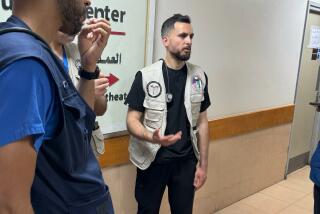Doctor Fights a ‘Genocide’ in Afghanistan
- Share via
A UCLA emergency room doctor secretly set up an emergency clinic in Afghanistan, returned home and asked for help from 52 health organizations to treat Afghan casualties of the fighting against Soviet troops.
After being turned down 52 times, Dr. Robert Simon sold his Malibu home to raise money for supplies and two more clinics and set up a permanent organization.
Now, two years later, the International Medical Corps treats about 54,000 patients each month at 24 clinics hidden in Afghan caves, on mountainsides, underground, and in tents and vacated buildings.
“We move them around to keep the Soviets guessing,” Simon said. “Most of the villagers know where the clinics are, and if they don’t, they find them by asking around.”
2 Clinics Destroyed, Rebuilt
The Soviets also locate the clinics, but they are placed where the Russian troops would suffer a large number of casualties if they attacked, Simon said. Still, two clinics have been destroyed and rebuilt.
About 100 doctors, nurses and assistants have left their practices in the United States for one to six months to join the IMC’s training center inside Pakistan near the Afghan border, where they teach surgical skills to Afghan civilians.
About 15 medical professionals go each month to the Pakistani center, where about 90 Afghan men, all medical novices, have been trained as advanced medics capable of performing surgery.
Of the 1,200 doctors in the country before the war, 200 are still practicing, Simon said, citing a report published in 1983 by a former professor of medicine and psychology at DePaul University.
TB, Measles Increase
Every health care facility in existence before the war was destroyed and the incidence of tuberculosis and measles had increased dramatically, Simon said.
That report spurred Simon to establish the first clinic and start the IMC.
To fund its clinics and training center, the IMC uses private donations and grants from the U.S. Agency for International Development. However, Executive Director Nancy Aossey said the IMC relies as much on donations as it did before it received its first AID grant in 1985.
Fund-raising and other administrative work is handled out of the IMC’s Los Angeles headquarters by Aossey, three full-time staff members and a board of directors that includes board Chairman Simon, other doctors, radio talk-show host Dennis Prager and business leaders.
“We’re growing quickly and we have accomplished quite a bit,” Aossey said. “We have kept the staff down to three because people find out and want to volunteer their time. The board members are very involved.”
Prager organized a successful concert fund-raiser held at the Music Center in June. Two board members used their business contacts to raise $25,000 for medical supplies in one week, Aossey said.
Saves Human Lives
“I think the organization is very important because of the impact it has had on saving human lives,” Aossey said. “During World War II, if an organization like the IMC had existed, it would have been a very different picture in terms of the Holocaust.
“The situation in Afghanistan is genocide,” Aossey said. “They are literally trying to destroy an entire population.”
The human rights organization Helsinki Watch has estimated that about 1 million people on both sides of the war have been killed since 1979. A United Nations report issued last month stated that nearly 12,000 Afghan civilians were killed in 1985.
Even against this stark backdrop, Aossey is confident that the IMC will continue to make an impact in Afghanistan.
“We have a goal of raising $2.2 million in the next 18 months so we can continue to help the Afghans,” Aossey said.
More to Read
Sign up for Essential California
The most important California stories and recommendations in your inbox every morning.
You may occasionally receive promotional content from the Los Angeles Times.













